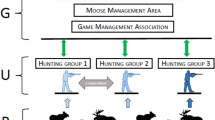Abstract
Increasing hunting pressure in Greenland demands improved knowledge on muskox (Ovibos moschatus) biology in general, and movement and grouping behaviour in particular, to ensure their proper management. Improving the exchange of information between hunters and managers is also necessary. Muskox site fidelity and group cohesion was examined over a 16-year period using 477 earmarked individuals tagged in 1982 and 1983. Combining information from scientists and hunters, observations of live individuals were primarily made from 1983 to 1990, while the latest tagged muskoxen reported shot were from 1998. Muskoxen in this area had a very loose group structure, with mother-young pairs as the only apparent bond between individuals. Furthermore, the tagged muskoxen lacked strong fidelity to the site where they were tagged and roamed within an 11,000-km2 area. Hunters reported tagged muskoxen shot up to 120 km away from the capture site. From the hunters’ reports, we determined that the central part of Jameson Land around Mikael Bjerg was the preferred hunting area in winter. In summer, most muskoxen were shot near the coast of the central part of Jameson Land. The hunter compliance in this study confirms that such cooperation can provide important information for management related to muskox harvesting and monitoring.




Similar content being viewed by others
References
Aastrup P, Mosbech A (2000) Population demography of the muskoxen in Jameson Land, 1982–1990. Rangifer 20:229–238
Clausen B, Hjort P, Strandgaard H, Soerensen PL (1984) Immobilization and marking of muskoxen (Ovibos moschatus) in Jameson Land, Northeastern Greenland. J Wildl Dis 20:141–145
Conradt L (1998) Measuring the degree of sexual segregation in group-living animals. J Anim Ecol 67:217–226
Data Solutions (1998) Range Manager. Copyright Data Solutions, St. Johns, Newfoundland
Festa-Bianchet M (1991) The social system of bighorn sheep: grouping patterns, kinship and female dominance rank. Anim Behav 42:71–82
Forchhammer M (1995) Sex, age and seasonal variation in the foraging dynamics of muskoxen, Ovibos moschatus, in Greenland. Can J Zool 73:1344–1361
Forchhammer M, Boertmann D (1993) The muskoxen Ovibos moschatus in north and northeast Greenland: population trends and the influence of abiotic parameters on population dynamics. Ecography 16:299–308
Fuller WA (1969) Behaviour and social organization of the wild bison of Wood Buffalo National Park, Canada. Arctic 13:3–19
Henrichsen P, Grue H (1980) Age criteria in the muskox (Ovibos moschatus) from Greenland. Dan Rev Game Biol 11:1–18
Leslie DM, Douglas CL (1979) Desert bighorn sheep of the River Moutains, Nevada. Wildl Monogr 66
Linnell JDC, Cuyler C, Loison A, Lund PM, Motzfeldt KG, Ingerslev T, Landa A (2000) The scientific basis for managing the sustainable harvest of caribou and muskoxen in Greenland for the 21st century: an evaluation and agenda. Technical report no. 34. Greenland Institute of Natural Resources, Pinngortitaleriffik
Lott DF, Minta SC (1983) Random individual association and social group instability in American bison (Bison bison). Z Tierpsychol 61:153–172
Meldgaard M (1986) The Greenland caribou—zoogeography, taxonomy, and population dynamics. Medd Grøn Biosci 20
Nuna Tek (1989) Klima. Jameson Land. Del I+del II, tabeller og figurer. Sektionen for Hydrotekniske Undersøgelser
Reynolds P (1993) Dynamics of muskox groups in northeastern Alaska. Rangifer 13:83–89
Sandell HT, Sandell B (1998) Muskox (Ovibos moschatus) hunting in Ittoqqortoormiit/Scoresbysund, North East Greenland. Étud Inuit 22:37–60
Thing H (1984) Food and habitat selection by muskoxen in Jameson Land, Northeast Greenland: a preliminary report. Biol Pap Alaska Spec Rep 4:69–74
Thing H, Klein DR, Jingfors K, Holt S (1987) Ecology of muskoxen in Jameson Land, Northeast Greenland. Holarct Ecol 10:95–103
Van Vuren D (1983) Group dynamics and summer home range of bison in southern Utah. J Mammal 64:329–332
Acknowledgements
I wish to thank the marking team, the hunters in Ittoqqortoormiit, the Governmental Office in Ittoqqortoormiit and all observers for their efforts. I especially want to thank Jonathan Colman for many valuable suggestions and for improving the language. I thank Jesper Madsen and Mikkel Tamstorf for critical comments on the first draft of the paper.
Author information
Authors and Affiliations
Corresponding author
Rights and permissions
About this article
Cite this article
Aastrup, P. Muskox site fidelity and group cohesion in Jameson Land, East Greenland. Polar Biol 27, 50–55 (2003). https://doi.org/10.1007/s00300-003-0565-1
Received:
Accepted:
Published:
Issue Date:
DOI: https://doi.org/10.1007/s00300-003-0565-1




